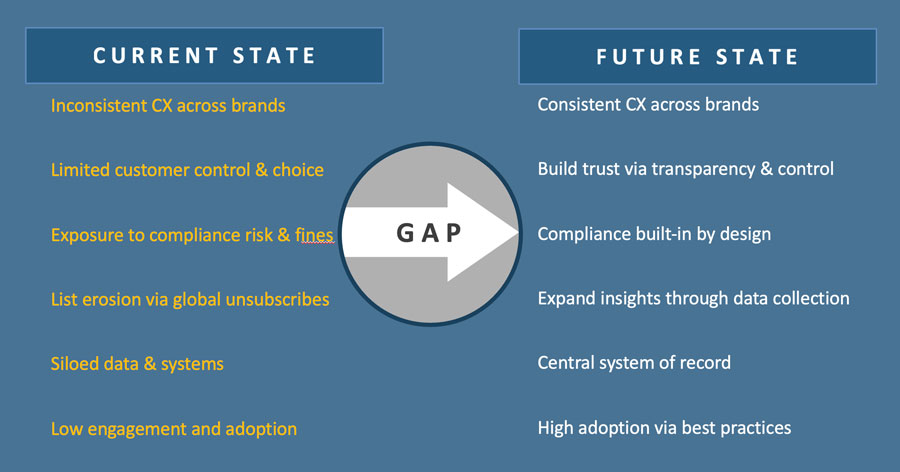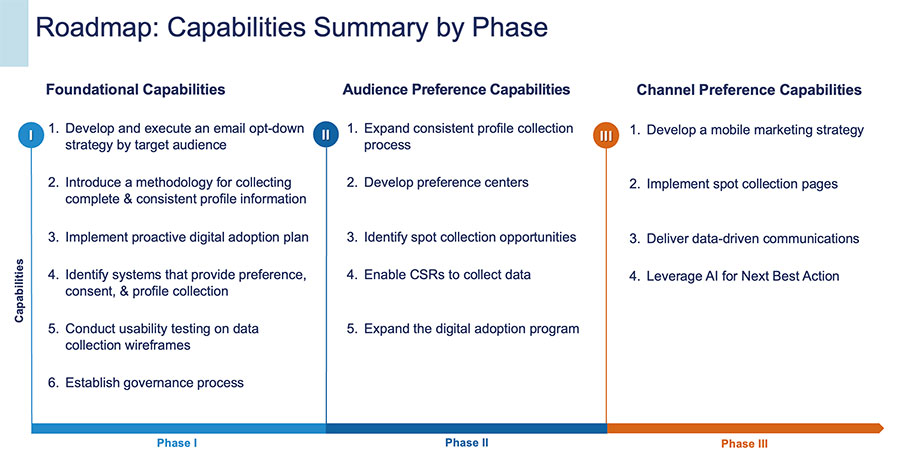Resource Center
Delivering Superior CX with Consent & Preference Data Requires a Strategic Approach
Type: Blog
Topic: Preference Mgmt

Maximizing the customer experience by implementing an organization-wide consent & preference solution is a complex, transformational initiative. It must include a governance team made up of people across the organization and well-thought-out systems and processes. Done right, you will not only avoid reputation and litigation risk but will also increase lifetime value of the customer.
Here is our recommended framework:
- Needs assessment. Determine your audience segments so you know how to build a consent and preference framework for each one (e.g. demographics, purchase history, etc.). Further, consider each segment’s propensity to share personal data. For example, younger audience segments are more comfortable with sharing data on social media, while older audience segments will likely require data collection through the call center or an email that links them to a data collection form.
- Gap analysis. Document the current state of the organization’s communications, compliance, systems, and processes. Then envision the desired future state, including data you require to meet customer needs.

- Data collection strategy. Identify at what point along the customer journey is most appropriate to collect specific data. Then establish the channels best used to collect the data and through what method – such as surveys, gamification, emails, or trust centers.
- Consent and Preference Data Mapping: The next foundational step is the strategic mapping and framework development of consent and preference data to ensure that engagement strategies are perfectly aligned with customer consents and preferences. Often referred to as a “taxonomy” approach, proper data mapping categorizes various consents and preferences related to customer communications into well-defined categories. Within these categories, audiences can be further segmented to identify more granular preferences, ensuring personalized and compliant communication strategies.
- Roadmap / Recommendations. Create a project plan that outlines what tasks need to be completed by phase. The milestones and tasks in each phase should be laid out strategically to gain early success and to build a foundation for future phases. For example, in Phase I, foundational capabilities such as implementing the infrastructure to collect and manage consent & preference data and providing customers the ability to opt-down provides the building blocks to introduce preferences centers and collect profile data in Phase II. In Phase III, you can add channels such as mobile and add spot collection at strategic places along the customer journey.

- Measure Success. As with any initiative, reporting on key metrics enables you to celebrate success and adjust when needed. Measuring success should be done across the customer journey (e.g. onboarding, customer service, loyalty). You can use AI to analyze and interpret preference data, understand where on the customer engagement index your customers are and what the next best action should be.
-
Difference Between Preferences & Consent
Type: Videos
Topic: Preference Mgmt
-
Data Silos Cause Communication Gaps
Type: Videos
Topic: Preference Mgmt
-
Integrate Do Not Call Compliance with Preferences
Type: Videos
Topic: Preference Mgmt
-
Customer Preferences Require More Than One Flavor
Type: Videos
Topic: Preference Mgmt
-
Give Customers Opt-Down Options
Type: Videos
Topic: Preference Mgmt
-
Preference Center Organization
Type: Videos
Topic: Preference Mgmt
-
Strategic Consultants Benefited Scotiabank
Type: Videos
Topic: Industry Testimonials
-
8 Best Practices for Capturing GDPR Consent
Type: Webinars
-
PossibleNOW Included in Independent Report on Top Emerging Technologies for B2C Marketers
Type: Press
-
PossibleNOW Solutions and Services Help Enterprise Companies Achieve GDPR Compliance
Type: Press
-
Making the Case for Consent and Preference Management
Type: Whitepapers
Topic: Consent Mgmt
Topic: Preference Mgmt
